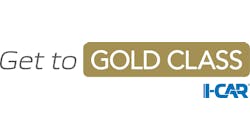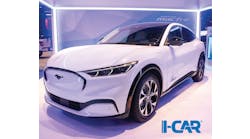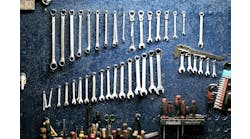It can be difficult to know where to begin when doing something as simple as trying out a new recipe—has the ingredient list been vetted? Does the recipe come from a reliable source? Were the instructions written in a clear, reasonable way? What about comments? What worked for others? What didn’t?
Proper repair specifications are much the same—constantly in flux, sometimes available from a variety of sources, and often leaving many shops and technicians flummoxed when it comes to knowing if they have the most up-to-date and approved collision repair instructions in hand.
Thankfully, I-CAR has a solution—Repairability Technical Support.
“Repairability Technical Support [RTS] is all about helping people find the right information no matter where it’s housed,” says Scott Van Hulle, Manager of RTS and & OEM Relations at I-CAR.
“It doesn’t matter if it’s stored at ALLDATA, CCC, Mitchell 1 or the OEM,” he says, “we’ll help the shop find that information.”
If one were to imagine a wheel and each spoke a different repair information source, I-CAR’s RTS database and team would comprise the center cog where all spokes meet. As the wheel of information continues to turn, I-CAR remains at its heart, no matter where the repairability road goes (or how bumpy the ride gets).
Van Hulle has been with I-CAR for a decade and cut his teeth as a collision repair technician before that. When he first took on the OEM relations role at I-CAR, his main function was to interact with the OEMs at the most basic, technical levels in order to understand the desired repair procedures and communicate that through I-CAR.
“That could be anything from an updated repair procedure, or, as the materials and technology advanced, answering the question, ‘can that even be repaired?’ ”
“Clarify & Verify” seems to be an apt mindset in contemporary collision repair. In addition to his role clarifying and verifying on behalf of all of I-CAR’s partners and collision technicians, Van Hulle also oversees the RTS program. His team built and manages the entire RTS portal housed at I-CAR.com.
“The RTS initiative began because the industry needed I-CAR to fill in some of the informational and technical gaps,” Van Hulle says.
“Collectively, we needed a single hub to turn to for correct answers because one thousand shops contacting OEMs on a daily basis wasn’t working.”
To meet the challenge, Van Hulle and his team changed “Tech Inquiries” to “Ask I-CAR” and the portal uses many filters in order to let shops know where the desired repair info is and how to find it. The website was developed to help people find the answers without calling anyone, and grew out of the need from the industry asking I-CAR to help solve the technical puzzle.
“The OEMs often come to us and ask, ‘what are you being asked on a daily basis?’ ”, he says.
“With all the ADAS information out there, we’re in the infancy stage of comprehensive repair procedures; it’s extremely advanced. The OEMs and other industry organizations are still figuring out how to deal with it.”
How RTS Services Works
Since its inception, I-CAR has existed for a single purpose—to streamline repair information and to assist collision repair technicians and shops to be informed, educated, and to make the most reliable repairs imaginable.
“Most of our partners just want the documentation,” Van Hulle says.
“They want to do it right. My team and I scour repair information every day, and if we find something unique or different or confusing, we’ll write an article. Sometimes the OEMs need to review it, and either way we’ll get that out to the industry as efficiently as possible. It may only be a small detail but it could completely change the repair—this is often the case with ADAS, for example.
“Training manuals will help with the more common repairs, but the collision repair news section of the website is updated every time we find something. The Hotspot page for calibration, for example, has a ton of the articles on calibration that we’ve written and if there’s a series of articles, we’ll have a wrap-up article with links to all the others.
“The Hotspot is a list of all generic articles, and another section of the OEM Information Pages features a button that will separate all the calibrations/ADAS articles we’ve written according to OEM. It’s constantly being updated for the benefit of our readers.”
Van Hulle views the RTS portal as more critical now than ever before. In a world dominated by the Google algorithm, a reliable and OEM-approved locus of vetted collision repair information is absolutely critical as new issues, challenges, technology and conflicting repair ideas arise day after day.
“When we first started, [RTS] was focused around high-strength steel; the industry was going through many changes at the time with structural materials. Now, we find the OEMs are giving us extremely detailed information but the industry has to play catch-up and follow the step-by-step procedures.”
Van Hulle cites a lack of sound general repair information because there’s nothing general to follow anymore—the days of popping the hood and diagnosing what’s wrong are long gone. Calibration and ADAS repair are extremely nuanced, and “the changes to repair procedures has made RTS extremely critical,” he says. Thus, I-CAR is here to help guide shops to the information they need without searching for hours on end for an answer that may not even exist.
A Resource by Car People for Car People
“This is a website built by car people for car people, so we’ve made it as intuitive as possible,” Van Hulle says.
“Just having the name of the OEM or part can save you hours and hours of time. If no calibration is required, we’ll put that in there to let you know don’t search for something that doesn’t exist.
“We’ve had people call us who say, ‘I’m looking for this,’ and we’ve had to tell them, ‘there’s nothing for that,’ and then they’ll say they’ve been looking for it for three hours,” he says, “or they’ll have spent all that precious time when they could have called us and had an answer in thirty seconds.”
Van Hulle says the most common RTS inquiries are for anything and everything affected by contemporary materials and ADAS changes; structural repair and replacements; cosmetic replacements; panel and component calibration; OEM position statements; corrosion protection; and more.
“It’s a wide gamut of requests,” he muses, “but the biggest questions remain around ADAS and repair versus replace.”
Depend on I-CAR RTS Links & Instruction
The RTS homepage is a treasure trove of contemporary repair information with dedicated links to various manufacturers’ procedures as well as categories broken out by:
OEM Calibration Requirements Search
OEM Partial Part Replacement Search
OEM Restraints System Part Replacement Search
The Road Ahead for I-CAR & RTS
With a robust system already in place, I-CAR plans to do what it does best—continue to provide cutting edge information to the shops and technicians who need it most.
“We just want to add more and more features,” Van Hulle says.
“There’s going to be more and more articles, and all the articles should tie to the I-CAR training courses related to that; if we have a course on the Subaru I-Sight system, for example, we’ll have access to that course from the manual to help technicians learn more about it.”
Van Hulle also looks forward to even more detailed information available from the search function, enabling technicians to more easily sift through the sea of information to find what they’re looking for. The portal will also feature different product and tool equipment and which tools to use on which vehicles.
More importantly, Van Hulle anticipates more direct collaboration with major third-party companies such as 3M, Polyvance, PPG, Car-O-Liner, ProSpot, Axalta and more; “We want more information about their products and known issues,” he says.
Van Hulle knows the repair industry often focuses on one issue at a time; several years ago it was high-strength steel and car body materials, then it was pre- and post-scan repair procedures, and now he sees the industry focusing on ADAS and calibrations. Van Hulle desires a more nuanced approach, and believes I-CAR can help foster a more holistic conversation about, well, everything else.
“Just because we’ve moved off of high-strength steel doesn’t mean those questions aren’t relevant—there’s crash-test adhesive, rivets in place of welds versus weld-for-weld, all while shops have different materials on hand from what is required.”
In other words, superseding one conversation for another as time and technology pass doesn’t just push those issues aside. It actually makes them more relevant, and Van Hulle is confident I-CAR has the personnel and know-how to continue to drive collision repair forward.
“Everyone [at RTS] at a minimum has been through tech school for collision repair,” he says, “and several of us have worked at shops and have first-hand experience. We try to look at it from a technician’s point of view. What the estimator and repairer need to know is that our driving force has always been to answer the question, ‘What do shops need today to fix this car?’ ”
Van Hulle recalls the moment realizing just how much repair information isn’t really out there. When you have access to the industry’s net repair procedures and resources, you’re more able to see the gaps in the process.
“The I-CAR team is turning from technicians being handed safety procedures to advocates for the right information. That’s very motivating.”
“And we want to make sure others don’t make the same mistake.”
To learn more, check out rts.i-car.com.




